What Does the Mother of the Bride Carry Down the Aisle? Essential Items for the Big Day
When attending a wedding, one aspect of ceremony tradition that often garners attention is what the mother of the bride carries down the aisle. This tradition is steeped in meaning and varies depending on cultural and familial customs. Typically, the mother of the bride may choose to carry a small bouquet of flowers, a clutch purse, or a meaningful memento. Whatever the item, it usually complements the wedding theme and signifies the mother’s role in the bride’s life and her journey to the altar.
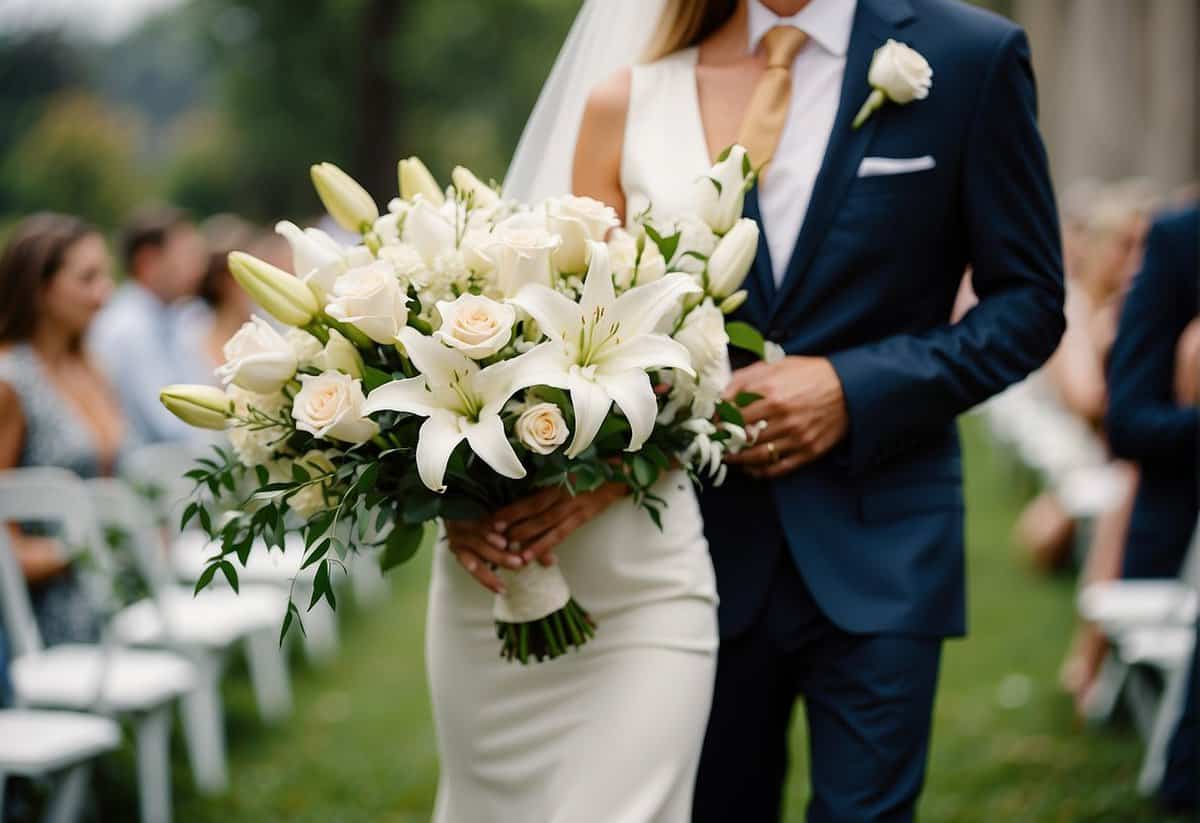
While some opt for the classic flower bouquet, others may select something more personal or practical. A clutch purse is particularly popular for its functionality and elegance, allowing the mother to keep personal items close while maintaining a polished look. On the other hand, carrying a sentimental keepsake can provide comfort and represent the family’s history as the bride steps into her future. It’s essential for the mother of the bride to feel comfortable and confident with her choice, as it contributes to the harmony and beauty of the occasion.
Key Takeaways
- The mother of the bride’s aisle accessory reflects tradition and personal taste.
- Options range from bouquets to clutches to sentimental items.
- The choice should harmonize with the wedding aesthetic and carry personal significance.
Traditional Roles and Responsibilities
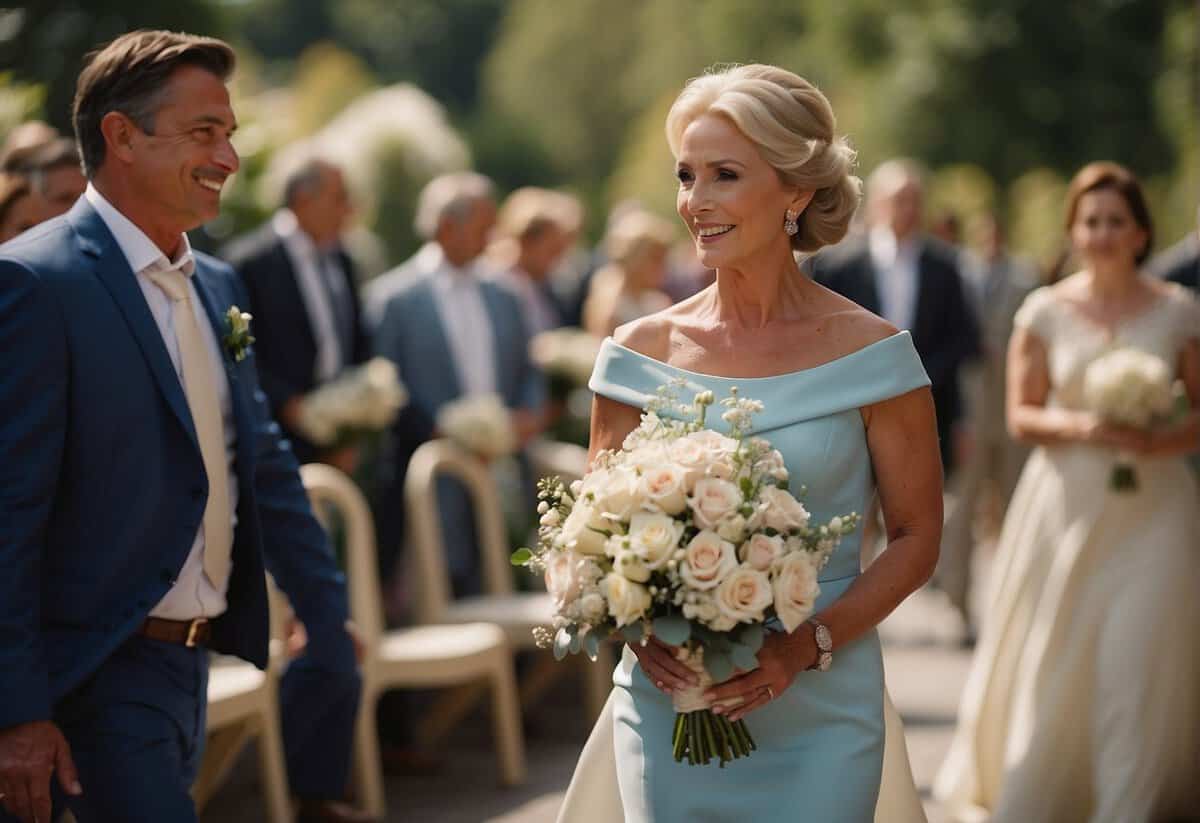
When attending a wedding, you’ll notice that the mother of the bride carries not just an air of pride and joy, but often a small clutch or bouquet as she walks down the aisle. This symbolizes her role in supporting her daughter on one of the most significant days of her life. Here’s a breakdown of what traditionally falls under her purview:
Support and Guidance: Your job is to be a pillar of support for your bride, offering advice and assistance as she navigates through wedding plans.
Family Liaison: You act as a bridge between the families, fostering a welcoming environment for the groom and his relatives.
Processional Dignity: During the wedding ceremony, you take a dignified walk during the processional, which honors your contribution to your daughter’s journey to this day.
Emotional Comfort: It’s common for emotions to run high, so offering a reassuring presence is paramount. A gesture as simple as a loving touch can mean the world to your daughter.
Ceremonial Duties: If tradition permits, you may be asked to light a candle or participate in a reading, symbolizing the family’s love and support.
Remember, it’s all about honoring the traditions that resonate with your family and blending them seamlessly into the celebration. As part of the wedding party, you help set the tone for the event, ensuring that the essence of honor and love is woven throughout the proceedings. Your role may vary depending on cultural expectations or the preference of your daughter and her officiant, but your presence is always cherished.
Processional and Ceremony Customs
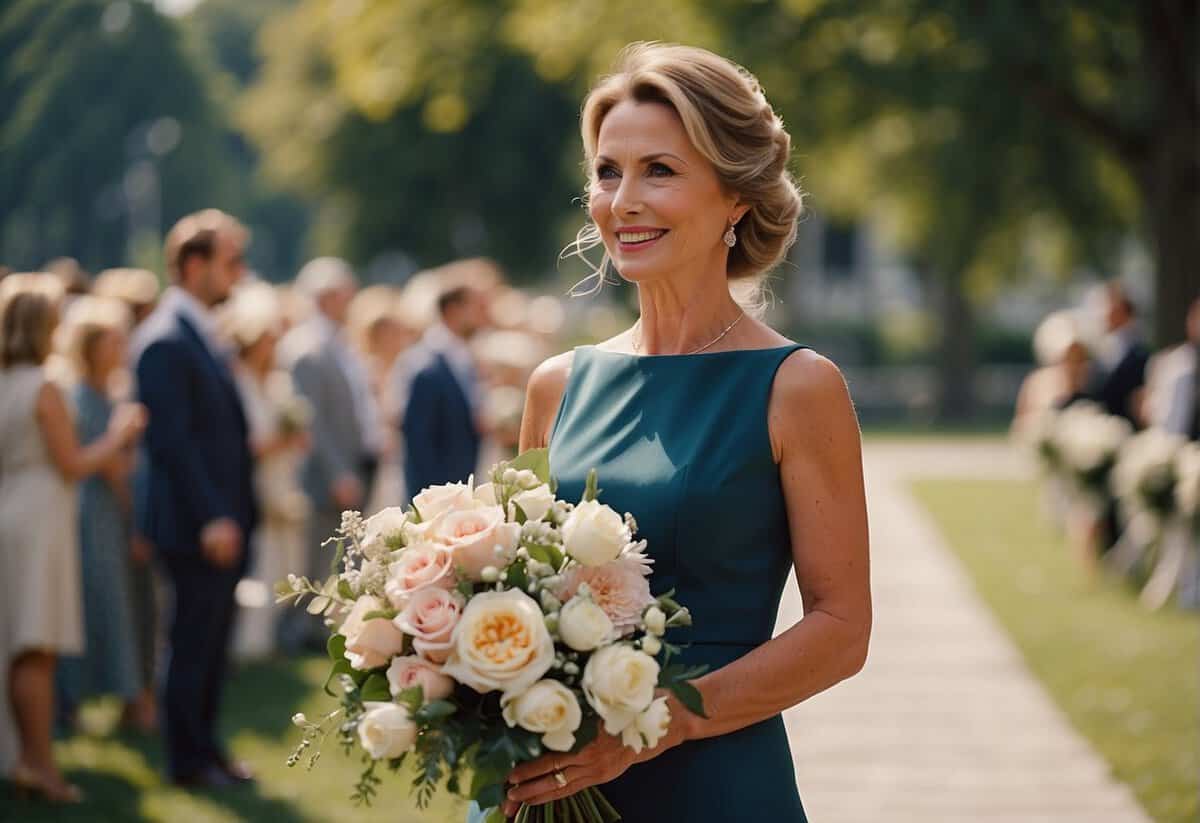
When attending a wedding, you’ll notice that the processional order is a significant tradition that guides how the wedding party enters and walks down the aisle. This order can vary greatly, depending on cultural and religious customs.
In a Christian wedding processional order, it’s common to see the officiant at the front, followed by the groom and his best man, and then the wedding party including the maid of honor, bridesmaids, and groomsmen. The flower girl and ring bearer often come next, with the families, including grandparents and siblings, being escorted to their seats. The father of the bride typically walks her down the aisle, while the mother of the bride may carry a small bouquet or a family heirloom as she takes her place. You can learn more about the Christian wedding processional from The Knot.
Jewish ceremonies may see the rabbi and cantor at the forefront, with grandparents and immediate family followed by the wedding party. The bride and groom are often escorted by both of their parents under the chuppah, symbolizing their new home. For details on the Jewish wedding processional, WeddingWire offers a clear guide.
In a Catholic wedding, similar to other Christian formats, there is a structured order starting with the priest, followed by the bridal party. The mother of the bride may be escorted in before the processional or as part of it, depending on family preference and church traditions.
For a Hindu wedding processional order, the groom’s arrival or baraat is a lively affair, with music and dancing preceding the ceremonial rituals under the mandap. Nondenominational weddings invite a more flexible approach, often tailored to the couple’s preference, maintaining respect for family dynamics.
Each tradition values inclusion and honors family roles, making the processional a reflective moment of unity and joy.
Mother of the Bride’s Attire and Accessories
When you, as the mother of the bride, prepare for the wedding day, your attire and accessories will play a crucial role in complementing the overall aesthetic of the celebration while reflecting the sentiment and support for your daughter’s special day.
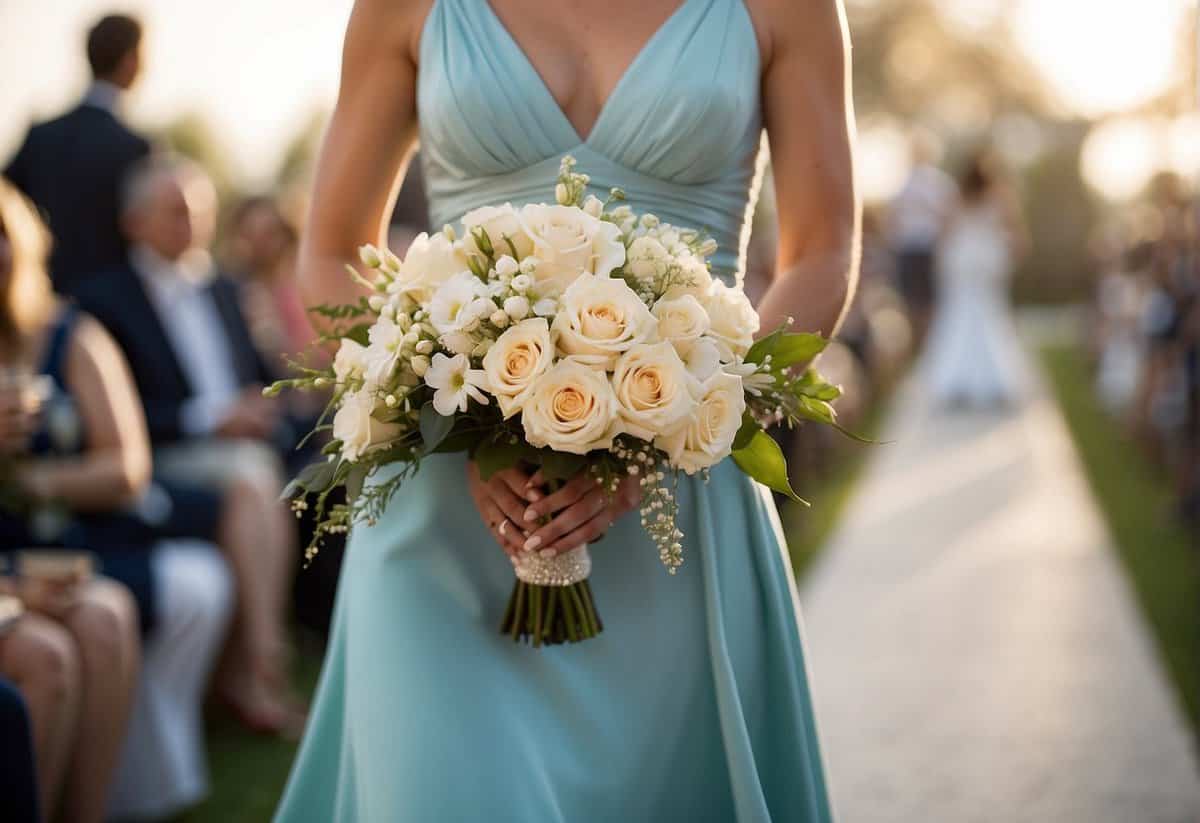
Choosing the Right Outfit
Selecting the perfect outfit is paramount. Your attire should coordinate with the wedding’s colors and themes, yet allow you to stand out subtly. It’s now commonly accepted to wear black to a wedding, should the event be a black-tie affair, while ensuring it aligns with the wedding’s formality and time of day. Always consult with the bride to ensure your outfit meshes well with her vision and doesn’t clash with the bridal party. A elegant dress or a sophisticated suit that flatters your figure and complements the wedding palette is often the best choice.
Accessorizing Appropriately
Your accessories add the finishing touches to your ensemble, so they merit thoughtful consideration. Jewelry should be elegant and not overshadow the bride; for instance, avoid noisy or uncomfortable pieces that could become a distraction. Traditionally, mothers may carry a bouquet or wear a corsage, but contemporary trends allow for more personalized options, like wearing a special flower in your hair. Each accessory should be selected to honor tradition and sentiment, without detracting from the bride’s spotlight.
Unique Expressions and Alternatives
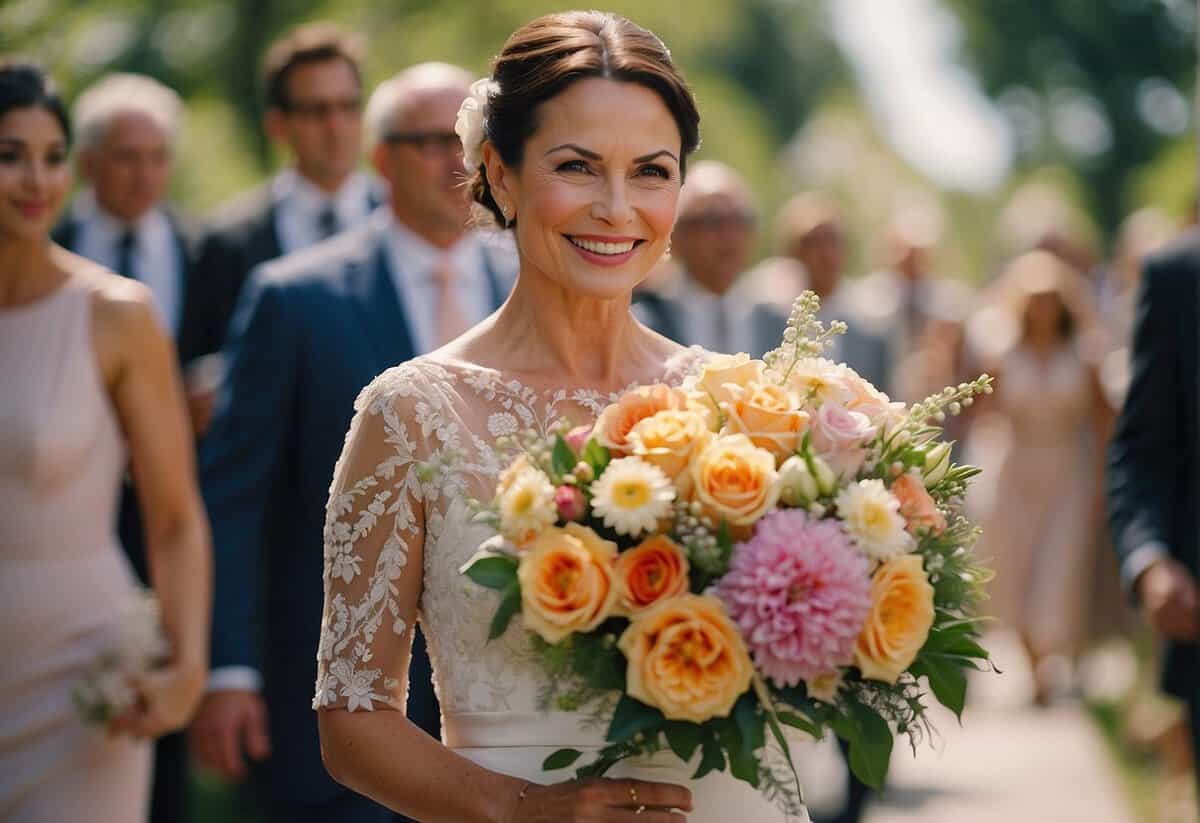
When considering what the mother of the bride carries down the aisle, there are numerous customs and traditions that can serve as inspiration, as well as many alternatives to choose from.
Cultural Influence: Are you embracing a particular cultural tradition? In some cultures, carrying a specific item might symbolize good fortune or blessings for the couple.
Thematic Elements: Does your celebration have a theme? If so, incorporating an element that complements the wedding’s motif can be a thoughtful touch.
Matching the Groom’s Parents: Traditionally, the mother of the groom might also make her way down the aisle. Coordinating what both mothers carry can be a harmonious gesture.
Corsages and Boutonnieres
- A wrist corsage or a boutonniere is a traditional and elegant choice.
- Bouquets: Smaller than the bride’s, these can mirror the wedding flowers.
Alternative Ideas
- Memory Items: A locket or a photo charm of loved ones to honor them.
- Candles: To symbolize the light and warmth they’ve brought into their child’s life.
- Family Heirloom: To pass down history and blessings to the couple.
For Step-Parents
Consider a gesture of inclusion, like a special memento they can carry for a sense of belonging and unity.
Surprise Element
- With the help of a wedding planner, you might opt for a surprise item to delight the guests and add a personal touch.
Remember, the most important aspect is the sentiment behind what you choose. It’s about celebrating your unique contribution to this milestone.
Frequently Asked Questions

When preparing for your daughter’s wedding, questions about your role can spring up. It’s essential to know your options, etiquette, and responsibilities to ensure the day goes smoothly.
What are some suitable alternatives to a corsage for the mother of the bride?
If you’re looking for an alternative to a traditional corsage, you might consider a small bouquet, a chic wristlet, a delicate floral pin, or even a special piece of jewelry that complements the wedding theme.
Can you explain the proper etiquette for mother of the bride flowers at a wedding?
Traditionally, the mother of the bride wears a corsage that coordinates with the wedding flowers. It should be less prominent than the bride’s bouquet but still significant enough to honor her position.
What are the traditional responsibilities of the mother of the bride on her daughter’s wedding day?
The mother of the bride typically helps with the wedding planning, supports the bride emotionally, oversees the guest list from her side of the family, and acts as a gracious hostess on the day of the wedding.
On which side should the mother of the bride wear her corsage?
The mother of the bride usually wears her corsage on the left side, mirroring the position where the bride’s father would wear his boutonniere.
Is it more common for the mother of the bride to wear a flower pin or a corsage?
While both options are suitable, the corsage is more traditional for the mother of the bride. However, the choice between a flower pin or corsage often depends on personal preference and the style of the dress.
What kind of gift is appropriate for the mother of the bride to give to the bride?
A sentimental gift such as a family heirloom, a piece of custom jewelry, or a handwritten letter is often considered appropriate and meaningful from the mother of the bride to the bride.
